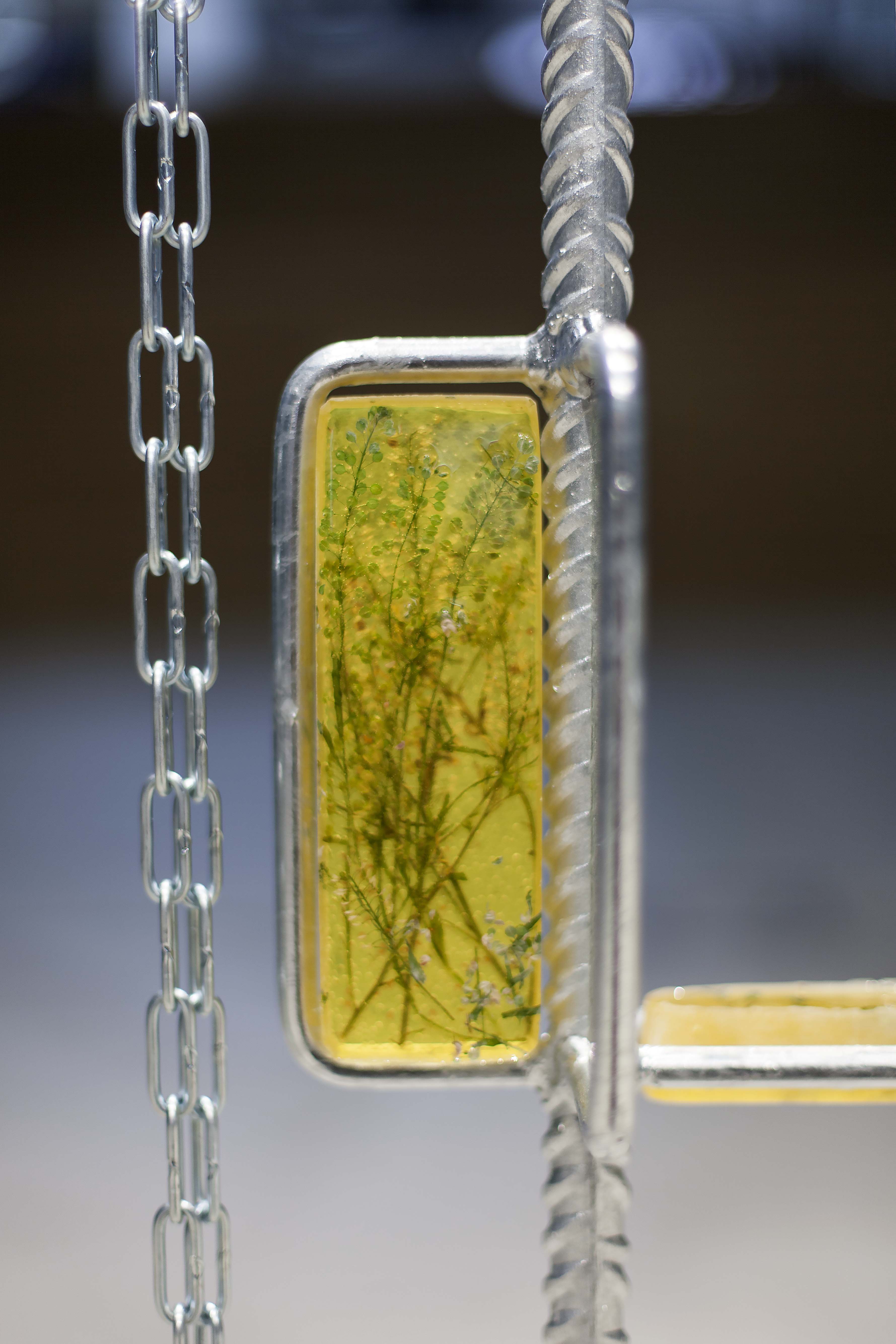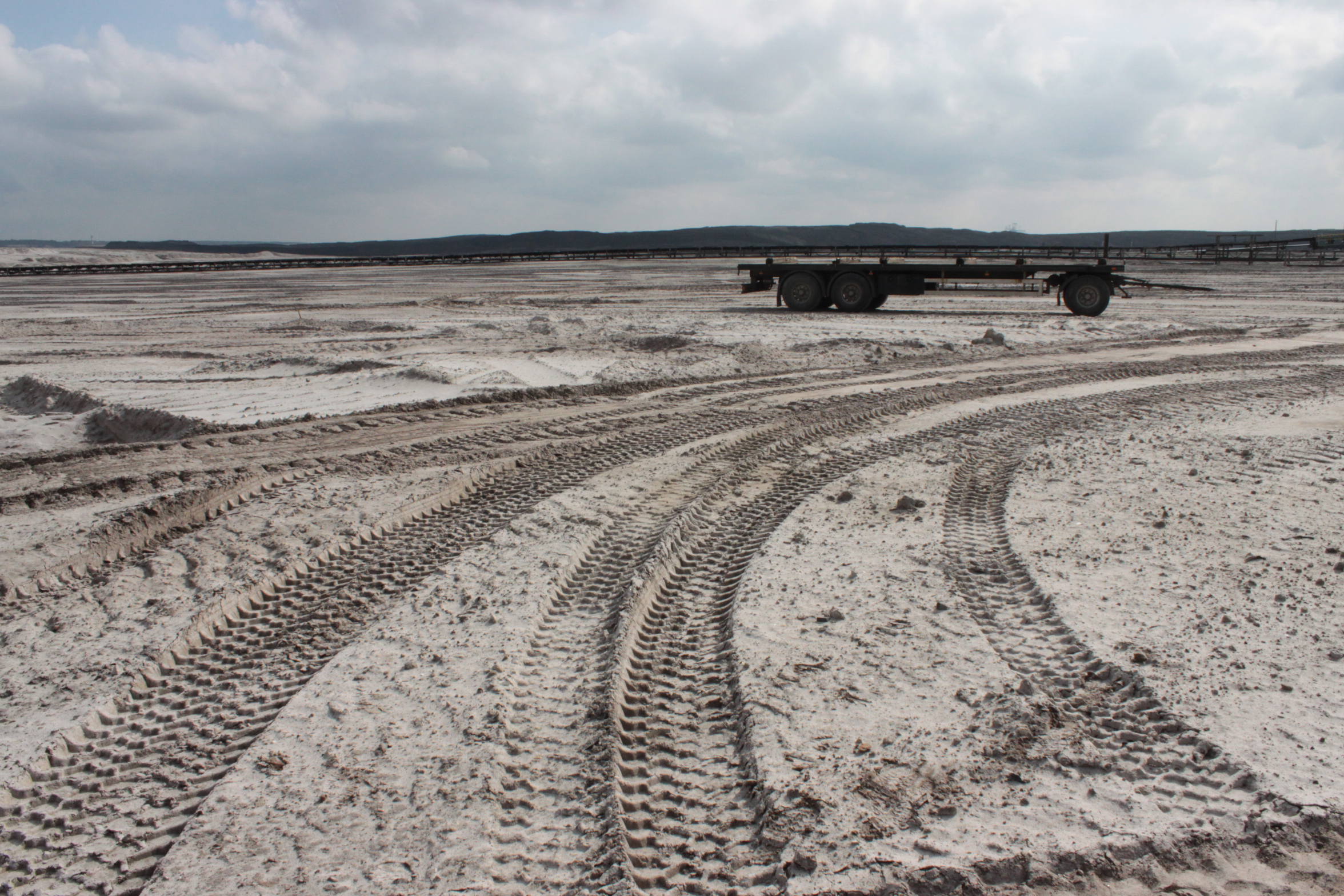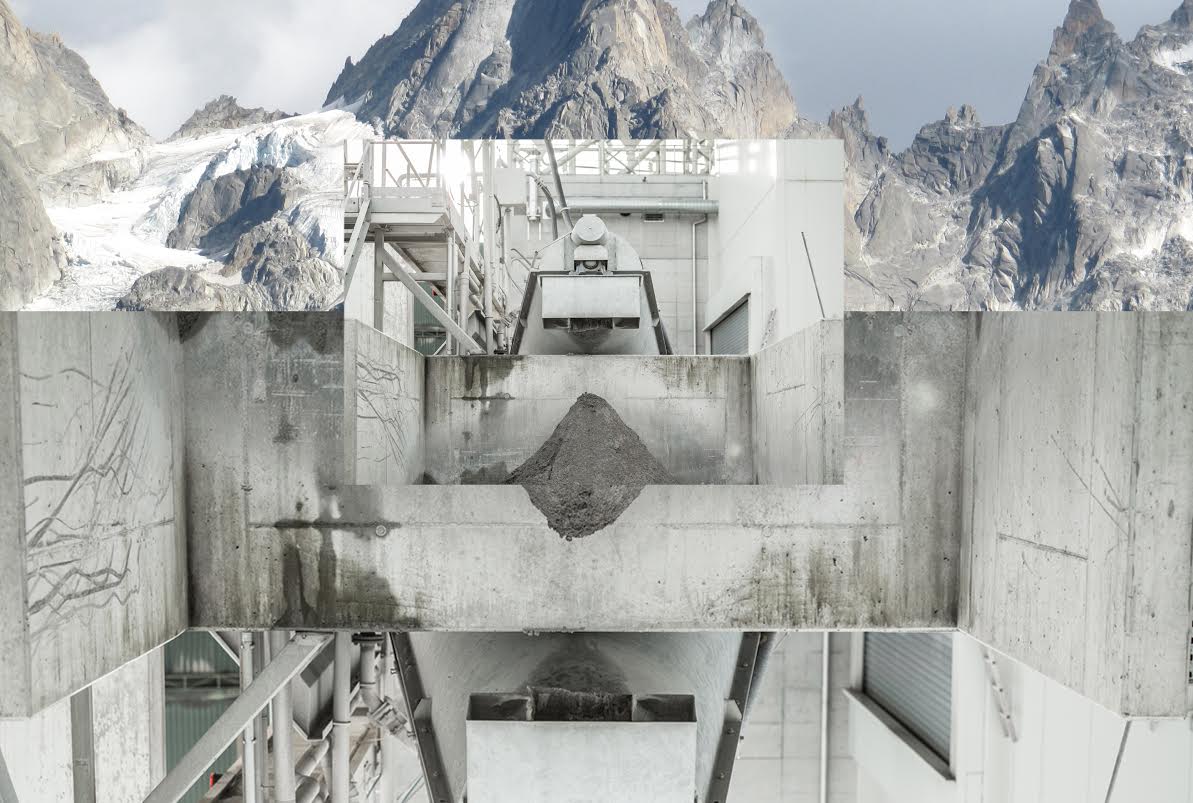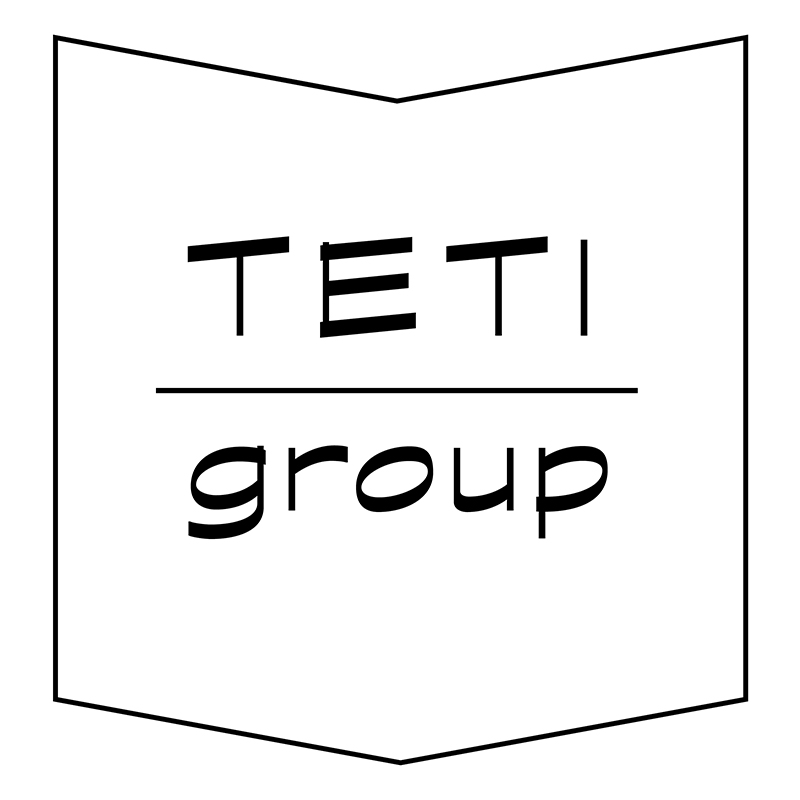 @AL.Franchette
'Baustelle und Botanik' - Chantier et botanique
TETI Group Learn project Anne-Laure Franchette & Gabriel Gee
"The land was untouched, calm and busy at once, unconcerned, when the dumper arrived, followed by tiltrotators, concrete pumps and cranes. Or perhaps it had already been shaped by human design when the bulldozers made their way through. In any case, the earth was turned, a mechanical ballet put in place to alter the nature of things. The building site ballet tells of things that were and things to come. For building sites are transitory spaces, in between time, but also forms. ‘Nature’, landscapes, pristine or hybrid, are shaped in the process of constructing. Our aim is to explore the way textures are literally and metaphorically stirred in a building site, and to explore the way it brings disorder upon the land to implement new orderings. Just as the model of the architect is not a mere reduction, a lesser entity than the building to come, but a matrix that contains the future to be, the building site speaks to the process of reality coming into form. We will look into the objects of the construction site, whose values rest largely into their function, despite their resilient aesthetic, and enquire upon their status in between the practical and the sculptural. We will consider the beings living onto a ground temporarily transformed into a wasteland, its particular ecosystem at the edge of civilization – where civilization comes into action, and being, but whose representative do no dwell in. And we will pay particular attention to the archeology of the building site, a place associated with archeologic exploration itself, as well as often constrained into per chance archeologic minutiae; yet whose own formation has much to say of our societies visions, desires, and muted mechanics. The building site, hidden behind tarpaulin and temporary walls, ultimately disappearing behind erected structures, offers a privileged entry into the unconscious forces of urban positivism. In The statuary gardens (1982), Jacques Abeille describes the visit of a traveller into the country of statuary gardens. There, the land secretes anthropomorphic statues, which are looked after by gardeners, from embryonic nascent shoots to full bloom. Similarly, the research project on ‘Baustelle und Botanik’ will aim to walk into the statuary gardens of our building sites, to glimpse the roots of our urban metabolic pulse."
The ground beneath our feet: tunnels, Hades, Unkraut
a conference about land and soil with artists, gardeners, architects and historians, which aims to look at the mobile ground beneath our feet, to interrogate the soil as both material and narrative in our interconnected territories and to reflect on the poet’s role in the definition of our contemporary imaginaries.
Event: Thursday 5 September 2019
Zürich Hoschule der Kunst
To retrieve his beloved wife, Eurydice, who on their wedding day died of a snake’s poisonous bite, Orpheus descends into the underworld, and sings his misery to the deities of the dark world beneath the earth. Moved by his pleas, Pluto grants him his wish, that they might ascend up to the light, on one condition: “if he turned his eyes to look at her, the gift of her delivery would be lost.” Orpheus ultimately cannot ‘not look back’ behind him turning his gaze from the sky and the air above to the pits of the earth. The underground and cavernous spirits inhabiting an ever-resurfacing past keeps tugging at those walking upon the earth. In the 1999 novel The ground beneath her feet, Salman Rushdie recast the Greek tale into the second half of the Twentieth century, where metamorphosis occur though the matrix of the popular music industry, globally connecting Bombay to New York, London and Mexico. The ground is no longer stable and always shifting, but still compels the livings to locate their roots. This takes place at The end of the modern world, as Irish poet Anthony Cronin versifies, where one wonders “What was it like in the garden? As naked a birch trees… Everything natural, instinctive, happy, No kinks, no hangs-up and no fetishes” (Cronin 2016), when the belonging came unquestioned. At the turn of the Twenty-First century, the ground beneath our feet is a terra mobile (Perulli 2014), where signs of spatial and social anchorage need to be redefined within a swirling matrix propelling individuals and communities within an ever more dizzying vortex begging the question of ‘where to land?’ (Latour 2018).
@AL.Franchette
'Baustelle und Botanik' - Chantier et botanique
TETI Group Learn project Anne-Laure Franchette & Gabriel Gee
"The land was untouched, calm and busy at once, unconcerned, when the dumper arrived, followed by tiltrotators, concrete pumps and cranes. Or perhaps it had already been shaped by human design when the bulldozers made their way through. In any case, the earth was turned, a mechanical ballet put in place to alter the nature of things. The building site ballet tells of things that were and things to come. For building sites are transitory spaces, in between time, but also forms. ‘Nature’, landscapes, pristine or hybrid, are shaped in the process of constructing. Our aim is to explore the way textures are literally and metaphorically stirred in a building site, and to explore the way it brings disorder upon the land to implement new orderings. Just as the model of the architect is not a mere reduction, a lesser entity than the building to come, but a matrix that contains the future to be, the building site speaks to the process of reality coming into form. We will look into the objects of the construction site, whose values rest largely into their function, despite their resilient aesthetic, and enquire upon their status in between the practical and the sculptural. We will consider the beings living onto a ground temporarily transformed into a wasteland, its particular ecosystem at the edge of civilization – where civilization comes into action, and being, but whose representative do no dwell in. And we will pay particular attention to the archeology of the building site, a place associated with archeologic exploration itself, as well as often constrained into per chance archeologic minutiae; yet whose own formation has much to say of our societies visions, desires, and muted mechanics. The building site, hidden behind tarpaulin and temporary walls, ultimately disappearing behind erected structures, offers a privileged entry into the unconscious forces of urban positivism. In The statuary gardens (1982), Jacques Abeille describes the visit of a traveller into the country of statuary gardens. There, the land secretes anthropomorphic statues, which are looked after by gardeners, from embryonic nascent shoots to full bloom. Similarly, the research project on ‘Baustelle und Botanik’ will aim to walk into the statuary gardens of our building sites, to glimpse the roots of our urban metabolic pulse."
The ground beneath our feet: tunnels, Hades, Unkraut
a conference about land and soil with artists, gardeners, architects and historians, which aims to look at the mobile ground beneath our feet, to interrogate the soil as both material and narrative in our interconnected territories and to reflect on the poet’s role in the definition of our contemporary imaginaries.
Event: Thursday 5 September 2019
Zürich Hoschule der Kunst
To retrieve his beloved wife, Eurydice, who on their wedding day died of a snake’s poisonous bite, Orpheus descends into the underworld, and sings his misery to the deities of the dark world beneath the earth. Moved by his pleas, Pluto grants him his wish, that they might ascend up to the light, on one condition: “if he turned his eyes to look at her, the gift of her delivery would be lost.” Orpheus ultimately cannot ‘not look back’ behind him turning his gaze from the sky and the air above to the pits of the earth. The underground and cavernous spirits inhabiting an ever-resurfacing past keeps tugging at those walking upon the earth. In the 1999 novel The ground beneath her feet, Salman Rushdie recast the Greek tale into the second half of the Twentieth century, where metamorphosis occur though the matrix of the popular music industry, globally connecting Bombay to New York, London and Mexico. The ground is no longer stable and always shifting, but still compels the livings to locate their roots. This takes place at The end of the modern world, as Irish poet Anthony Cronin versifies, where one wonders “What was it like in the garden? As naked a birch trees… Everything natural, instinctive, happy, No kinks, no hangs-up and no fetishes” (Cronin 2016), when the belonging came unquestioned. At the turn of the Twenty-First century, the ground beneath our feet is a terra mobile (Perulli 2014), where signs of spatial and social anchorage need to be redefined within a swirling matrix propelling individuals and communities within an ever more dizzying vortex begging the question of ‘where to land?’ (Latour 2018).
 @Grit Ruhland
This day study aims to look at this mobile ground beneath our feet, to interrogate the soil as both material and narrative in our interconnected territories, and to reflect on the poet’s role in the definition of our contemporary imaginaries. In particular, presentations and discussions will explore ties to the past stored beneath the ground, and the channels that can connect us to known and forgotten territorial memories; it will consider the dark side of the underworld, the hidden layers of death, waste and oblivion, but also the force of spectral voices as they reach out summoned or not from the depth of the earth; and finally it will reflect on the generative energy of the soil, through the lens of the vagabondes, the nomadic crops and energy that settle uncalled for at the heart of our fields, gardens, cities, and that might offer an alternate path for the design of our commons to be and to become.
Gabriel Gee & Anne-Laure Franchette
Morning (10h-12h30)
Welcome and introductory words, Gabriel Gee (Lugano - Zurich)
Anne-Laure Franchette (Paris - Zurich), ‘Grands travaux urbains’
Nikos Doulos (Amsterdam - Athens) Exercises on Walking Home: Modes of plunging in and resurfacing in the Athenian topology.
Grit Ruhland (Dresden), Awesome Terra – Ambivalent Relations to Ground: From Myth to Mining and Repository with Particular Regard to Uranium
Maria-Joao Matos (Lisbon), The idea of European landscape
Afternoon (14h-16h30)
Maurice Maggi (Zurich), New habitats for biodiversity in the city
Jan Van Oordt (St Imier), La dependance: territory, surroundings, construction site
Errol Reuben Fernandes (London), An unearthed identity - Creation of a new order
Michael Hiltbrunner (Zurich), Soil, Unkraut, commons: shifting grounds and nomadism
17h Group Conversation & apero: Connections and Future Forays
LAND, SOIL, AESTHETICS
Event: Friday June 7th 2019
at the Zürcher Hoschule for angewandte Wissenschaft (ZHAW),
in Wädenswill, 2pm
with Monica Ursina Jäger
Maya Minder & Bad Lab
as part of a School of Commons Learn
@Grit Ruhland
This day study aims to look at this mobile ground beneath our feet, to interrogate the soil as both material and narrative in our interconnected territories, and to reflect on the poet’s role in the definition of our contemporary imaginaries. In particular, presentations and discussions will explore ties to the past stored beneath the ground, and the channels that can connect us to known and forgotten territorial memories; it will consider the dark side of the underworld, the hidden layers of death, waste and oblivion, but also the force of spectral voices as they reach out summoned or not from the depth of the earth; and finally it will reflect on the generative energy of the soil, through the lens of the vagabondes, the nomadic crops and energy that settle uncalled for at the heart of our fields, gardens, cities, and that might offer an alternate path for the design of our commons to be and to become.
Gabriel Gee & Anne-Laure Franchette
Morning (10h-12h30)
Welcome and introductory words, Gabriel Gee (Lugano - Zurich)
Anne-Laure Franchette (Paris - Zurich), ‘Grands travaux urbains’
Nikos Doulos (Amsterdam - Athens) Exercises on Walking Home: Modes of plunging in and resurfacing in the Athenian topology.
Grit Ruhland (Dresden), Awesome Terra – Ambivalent Relations to Ground: From Myth to Mining and Repository with Particular Regard to Uranium
Maria-Joao Matos (Lisbon), The idea of European landscape
Afternoon (14h-16h30)
Maurice Maggi (Zurich), New habitats for biodiversity in the city
Jan Van Oordt (St Imier), La dependance: territory, surroundings, construction site
Errol Reuben Fernandes (London), An unearthed identity - Creation of a new order
Michael Hiltbrunner (Zurich), Soil, Unkraut, commons: shifting grounds and nomadism
17h Group Conversation & apero: Connections and Future Forays
LAND, SOIL, AESTHETICS
Event: Friday June 7th 2019
at the Zürcher Hoschule for angewandte Wissenschaft (ZHAW),
in Wädenswill, 2pm
with Monica Ursina Jäger
Maya Minder & Bad Lab
as part of a School of Commons Learn
 READ THE WORKSHOP NOTES HERE
Event
Saturday January 26 2019
at Zhdk, Toni Areal 5.KO3
2pm Panel discussion School of Commons, moderated by Marea Hildebrand
4pm 'Between soil and ground:' in conversation with artist Monica Ursina Jäger,
with Anne-Laure Franchette & Gabriel Gee
READ THE WORKSHOP NOTES HERE
Event
Saturday January 26 2019
at Zhdk, Toni Areal 5.KO3
2pm Panel discussion School of Commons, moderated by Marea Hildebrand
4pm 'Between soil and ground:' in conversation with artist Monica Ursina Jäger,
with Anne-Laure Franchette & Gabriel Gee
 @MU.Jager
@MU.Jager
